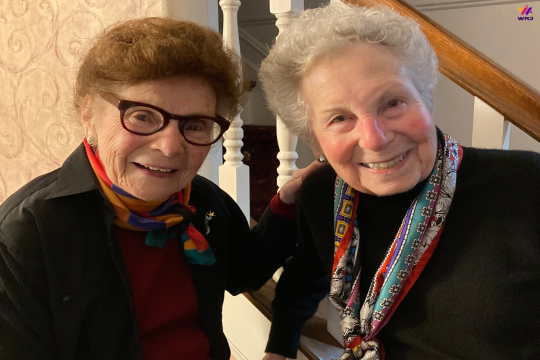By Nancy J. Apfel
Today’s foodie culture has brought with it a growing interest in eating habits and cookbooks. A recent New York Times list of bestsellers in the Advice and Miscellaneous category included 11 books about nutrition and cooking in the top 15 sellers. Food blogs and reality cooking shows have a wide following.
It should come as no surprise that WRJ and local Sisterhoods were ahead of the times. They have been compiling cookbooks for more than a century and assembling a collection since the since the 1990’s.
The impetus for creating a cookbook collection began with Betty Eichenbaum Benjamin, past president of National Federation of Temple Sisterhoods (now Women of Reform Judaism), who acquired a collection of thirty-two Sisterhood cookbooks as she traveled across North America in the 1960s and 1970s for NFTS. Dr. Herbert Zafren, Hebrew Union College - Jewish Institute of Religion Librarian Emeritus, recognizing that cookbooks provide more than simply recipes, suggested to Betty that she donate her cookbooks to the library in October of 1995.
Knowing that numerous Sisterhoods have published cookbooks, Betty spoke with Dr. David Gilner, director of libraries for HUC-JIR, about expanding her cookbook collection. Dr. Gilner was most enthusiastic. Betty recommended to WRJ President Judith Rosenkranz that WRJ create a collection of Sisterhood cookbooks to be housed at the library. At its board meeting in May 1996, the WRJ Board of Directors approved plans to establish a collection of Sisterhood cookbooks at HUC-JIR Library in Cincinnati. Nancy J. Apfel was appointed chair of the project.
The individual cookbooks in the WRJ Cookbook Collection reflect the Sisterhood, the times, and the culture of the congregation. They also offer insights into the women whose recipes are included in the cookbook. The overall collection itself is historically significant and provides a commentary on our Jewish heritage.
WRJ Centennial Academic Symposium Scholar Dr. Deborah Dash Moore, Professor of History and Director of the Center for Judaic Studies, University of Michigan, notes that cookbooks reflect the rise of literacy and the increase in women’s mobility. It wasn’t until the 19th century that cookbooks came into existence. Prior to that time, women typically did not write down their recipes. They used, and continue to use, cooking as a way to pass Judaism and family traditions on to future generations.
The HUC-JIR library is believed to have the largest collection of Jewish cookbooks in a single facility.
To date, there are 263 books in the WRJ Collection representing 35 states and the District of Columbia as well as Great Britain, Brazil, British Columbia, Switzerland, and Panama. The publication dates of the cookbooks in the collection span 124 years. The oldest book in the collection is THE FAIR COOKBOOK, published in 1888 by the Ladies of Congregation Emanuel in Denver, Colorado. The newest cookbook in the collection was published in 2012. Sisterhoods in California have published the most cookbooks in the collection, followed by Sisterhoods in New York and Ohio.
The cookbooks in the collection vary widely in size and format. They are handwritten, typed, computer generated, or professionally typeset. Some books have colorful hard covers and are bound with glue; others use a heavy paper cover and are bound with either a plastic or spiral coil. Some cookbooks are in loose-leaf binders and a few are bound with large silver rings. One Sisterhood printed the recipes on 5” x 8” file cards and stored them in a metal filing box that the women decorated using decoupage. While some cookbooks are illustrated professionally, others contain artwork drawn by Sisterhood members or their children. One cookbook is a large-print book.
In the preface to their cookbook published in 2004, the Indianapolis Hebrew Congregation Temple Sisterhood wrote, “Jewish cooking is a unique synthesis of cooking styles from the many places that Jews have lived throughout the centuries. Jewish cooking shows the influence of Middle Eastern, Mediterranean, Spanish, German, and Eastern European styles of cooking, all influenced by the unique dietary constraints of kashrut and other Jewish laws. Many of the foods that we think of as Jewish are not unique to Jewish culture.”
WRJ has selected recipes from the collection representing different eras and locales and make them available for download on the website. Currently the site is highlighting Purim recipes, which we will celebrate on February 24, 2013.
Nancy J. Apfel became a sisterhood volunteer following her mother's lead and has been involved on the local (past president of the Isaac M. Wise Temple Sisterhood), district, (past president of District 10 - WRJ Central District); and North American levels (currently on the WRJ board of directors). She is a cookbook reader and collector; chairing this cookbook collection has been a labor of love.
The WRJ Ten Minutes of Torah series is sponsored by the Blumstein Family Fund.
Related Posts
Image

Andrea Stillman: A WRJ Leadership Spotlight
This week, Women of Reform Judaism interviewed Executive Committee member and Mid-Atlantic District President Andrea Stillman. Read more to learn about her leadership journey with WRJ, and watch Andrea’s video Q&A here. How did you come to be a WRJ leader? That's a very easy answer for me.
Image

Celebrating 100 Years: A Journey Through Time
This year my congregation is celebrating a very special milestone: the 100-year anniversary of our community. Temple Israel Long Beach in southern California was chartered in February 1924. For this important anniversary, the temple has been celebrating with many events throughout the year.
Image
Celebrating the Mothers of Israel: A Women’s Seder
Several weeks ago, I was asked to write something for this blog about a program called ‘Celebrating the Mothers of Israel,’ which would have been cool, but we hadn’t in fact had a program with that name.
